Heng Chang
GraphRAG-R1: Graph Retrieval-Augmented Generation with Process-Constrained Reinforcement Learning
Jul 31, 2025Abstract:Graph Retrieval-Augmented Generation (GraphRAG) has shown great effectiveness in enhancing the reasoning abilities of LLMs by leveraging graph structures for knowledge representation and modeling complex real-world relationships. However, existing GraphRAG methods still face significant bottlenecks when handling complex problems that require multi-hop reasoning, as their query and retrieval phases are largely based on pre-defined heuristics and do not fully utilize the reasoning potentials of LLMs. To address this problem, we propose GraphRAG-R1, an adaptive GraphRAG framework by training LLMs with process-constrained outcome-based reinforcement learning (RL) to enhance the multi-hop reasoning ability. Our method can decompose complex problems, autonomously invoke retrieval tools to acquire necessary information, and perform effective reasoning. Specifically, we utilize a modified version of Group Relative Policy Optimization (GRPO) that supports rollout-with-thinking capability. Next, we design two process-constrained reward functions. To handle the shallow retrieval problem, we design a Progressive Retrieval Attenuation (PRA) reward to encourage essential retrievals. Then, to handle the over-thinking problem, we design Cost-Aware F1 (CAF) reward to balance the model performance with computational costs. We further design a phase-dependent training strategy, containing three training stages corresponding to cold start and these two rewards. Lastly, our method adopts a hybrid graph-textual retrieval to improve the reasoning capacity. Extensive experimental results demonstrate that GraphRAG-R1 boosts LLM capabilities in solving complex reasoning problems compared to state-of-the-art GraphRAG methods on both in-domain and out-of-domain datasets. Furthermore, our framework can be flexibly integrated with various existing retrieval methods, consistently delivering performance improvements.
VReST: Enhancing Reasoning in Large Vision-Language Models through Tree Search and Self-Reward Mechanism
Jun 10, 2025Abstract:Large Vision-Language Models (LVLMs) have shown exceptional performance in multimodal tasks, but their effectiveness in complex visual reasoning is still constrained, especially when employing Chain-of-Thought prompting techniques. In this paper, we propose VReST, a novel training-free approach that enhances Reasoning in LVLMs through Monte Carlo Tree Search and Self-Reward mechanisms. VReST meticulously traverses the reasoning landscape by establishing a search tree, where each node encapsulates a reasoning step, and each path delineates a comprehensive reasoning sequence. Our innovative multimodal Self-Reward mechanism assesses the quality of reasoning steps by integrating the utility of sub-questions, answer correctness, and the relevance of vision-language clues, all without the need for additional models. VReST surpasses current prompting methods and secures state-of-the-art performance across three multimodal mathematical reasoning benchmarks. Furthermore, it substantiates the efficacy of test-time scaling laws in multimodal tasks, offering a promising direction for future research.
MuseFace: Text-driven Face Editing via Diffusion-based Mask Generation Approach
Mar 31, 2025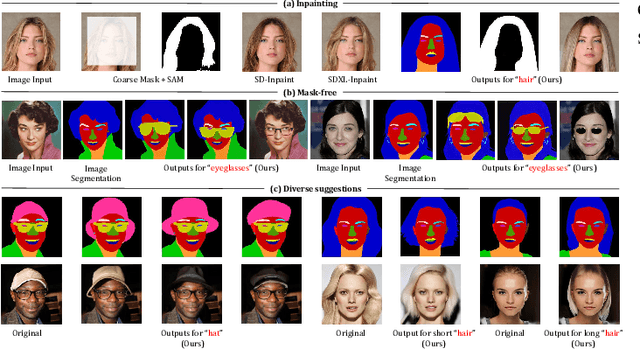
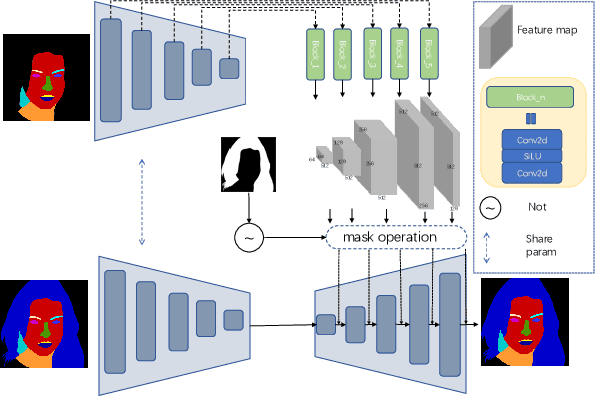
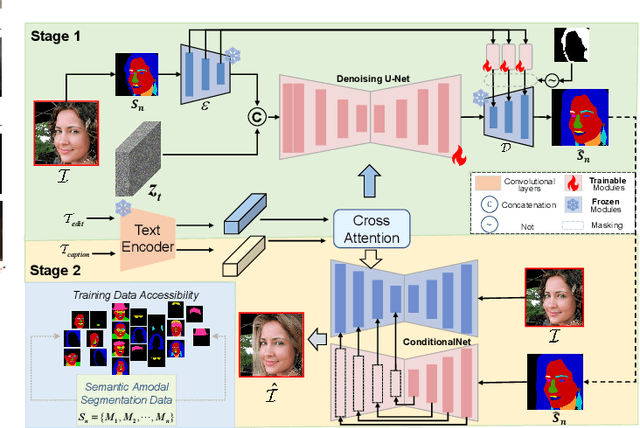
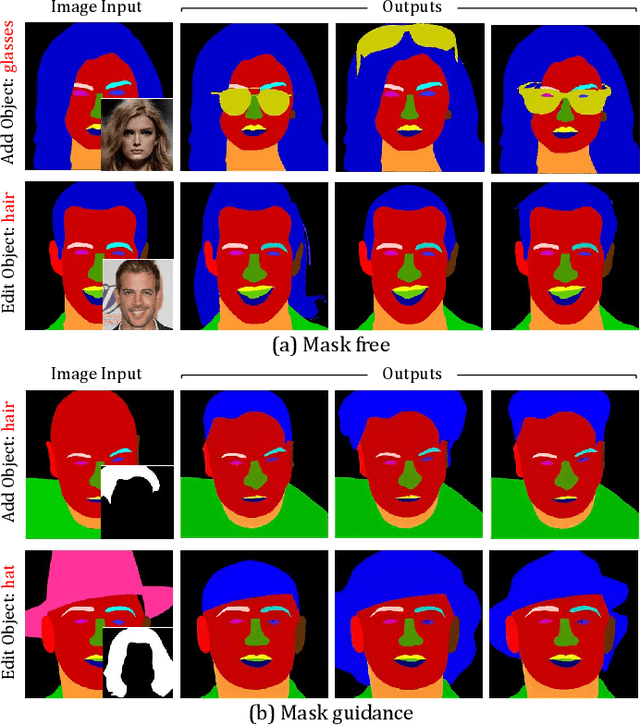
Abstract:Face editing modifies the appearance of face, which plays a key role in customization and enhancement of personal images. Although much work have achieved remarkable success in text-driven face editing, they still face significant challenges as none of them simultaneously fulfill the characteristics of diversity, controllability and flexibility. To address this challenge, we propose MuseFace, a text-driven face editing framework, which relies solely on text prompt to enable face editing. Specifically, MuseFace integrates a Text-to-Mask diffusion model and a semantic-aware face editing model, capable of directly generating fine-grained semantic masks from text and performing face editing. The Text-to-Mask diffusion model provides \textit{diversity} and \textit{flexibility} to the framework, while the semantic-aware face editing model ensures \textit{controllability} of the framework. Our framework can create fine-grained semantic masks, making precise face editing possible, and significantly enhancing the controllability and flexibility of face editing models. Extensive experiments demonstrate that MuseFace achieves superior high-fidelity performance.
Separated Contrastive Learning for Matching in Cross-domain Recommendation with Curriculum Scheduling
Feb 22, 2025



Abstract:Cross-domain recommendation (CDR) is a task that aims to improve the recommendation performance in a target domain by leveraging the information from source domains. Contrastive learning methods have been widely adopted among intra-domain (intra-CL) and inter-domain (inter-CL) users/items for their representation learning and knowledge transfer during the matching stage of CDR. However, we observe that directly employing contrastive learning on mixed-up intra-CL and inter-CL tasks ignores the difficulty of learning from inter-domain over learning from intra-domain, and thus could cause severe training instability. Therefore, this instability deteriorates the representation learning process and hurts the quality of generated embeddings. To this end, we propose a novel framework named SCCDR built up on a separated intra-CL and inter-CL paradigm and a stop-gradient operation to handle the drawback. Specifically, SCCDR comprises two specialized curriculum stages: intra-inter separation and inter-domain curriculum scheduling. The former stage explicitly uses two distinct contrastive views for the intra-CL task in the source and target domains, respectively. Meanwhile, the latter stage deliberately tackles the inter-CL tasks with a curriculum scheduling strategy that derives effective curricula by accounting for the difficulty of negative samples anchored by overlapping users. Empirical experiments on various open-source datasets and an offline proprietary industrial dataset extracted from a real-world recommender system, and an online A/B test verify that SCCDR achieves state-of-the-art performance over multiple baselines.
G-Refer: Graph Retrieval-Augmented Large Language Model for Explainable Recommendation
Feb 18, 2025Abstract:Explainable recommendation has demonstrated significant advantages in informing users about the logic behind recommendations, thereby increasing system transparency, effectiveness, and trustworthiness. To provide personalized and interpretable explanations, existing works often combine the generation capabilities of large language models (LLMs) with collaborative filtering (CF) information. CF information extracted from the user-item interaction graph captures the user behaviors and preferences, which is crucial for providing informative explanations. However, due to the complexity of graph structure, effectively extracting the CF information from graphs still remains a challenge. Moreover, existing methods often struggle with the integration of extracted CF information with LLMs due to its implicit representation and the modality gap between graph structures and natural language explanations. To address these challenges, we propose G-Refer, a framework using graph retrieval-augmented large language models (LLMs) for explainable recommendation. Specifically, we first employ a hybrid graph retrieval mechanism to retrieve explicit CF signals from both structural and semantic perspectives. The retrieved CF information is explicitly formulated as human-understandable text by the proposed graph translation and accounts for the explanations generated by LLMs. To bridge the modality gap, we introduce knowledge pruning and retrieval-augmented fine-tuning to enhance the ability of LLMs to process and utilize the retrieved CF information to generate explanations. Extensive experiments show that G-Refer achieves superior performance compared with existing methods in both explainability and stability. Codes and data are available at https://github.com/Yuhan1i/G-Refer.
EvoFlow: Evolving Diverse Agentic Workflows On The Fly
Feb 11, 2025



Abstract:The past two years have witnessed the evolution of large language model (LLM)-based multi-agent systems from labor-intensive manual design to partial automation (\textit{e.g.}, prompt engineering, communication topology) and eventually to fully automated design. However, existing agentic automation pipelines often lack LLM heterogeneity and focus on single-objective performance optimization, limiting their potential to combine weaker models for more customized and cost-effective solutions. To address this challenge, we propose EvoFlow, a niching evolutionary algorithm-based framework to automatically search a population of heterogeneous and complexity-adaptive agentic workflows, rather than a single homogeneous, complex workflow. Technically, EvoFlow performs \textit{(1) tag-based retrieval} to extract parent workflows from an agentic population, evolves new workflows through \textit{(2) crossover} and \textit{(3) mutation}, and employs \textit{(4) niching-based selection} to maintain population diversity and quality. Extensive evaluations across seven benchmarks demonstrate that EvoFlow is: \textbf{(I) diverse}, evolving a population of workflows ranging from simple I/O tasks to complex multi-turn interactions; \textbf{(II) high-performing}, outperforming previous handcrafted and automated workflows by $1.23\%\sim29.86\%$; \textbf{(III) economical}, surpassing powerful \llmname{o1-preview} at $12.4\%$ of its inference cost using weaker open-source models.
PointTalk: Audio-Driven Dynamic Lip Point Cloud for 3D Gaussian-based Talking Head Synthesis
Dec 11, 2024



Abstract:Talking head synthesis with arbitrary speech audio is a crucial challenge in the field of digital humans. Recently, methods based on radiance fields have received increasing attention due to their ability to synthesize high-fidelity and identity-consistent talking heads from just a few minutes of training video. However, due to the limited scale of the training data, these methods often exhibit poor performance in audio-lip synchronization and visual quality. In this paper, we propose a novel 3D Gaussian-based method called PointTalk, which constructs a static 3D Gaussian field of the head and deforms it in sync with the audio. It also incorporates an audio-driven dynamic lip point cloud as a critical component of the conditional information, thereby facilitating the effective synthesis of talking heads. Specifically, the initial step involves generating the corresponding lip point cloud from the audio signal and capturing its topological structure. The design of the dynamic difference encoder aims to capture the subtle nuances inherent in dynamic lip movements more effectively. Furthermore, we integrate the audio-point enhancement module, which not only ensures the synchronization of the audio signal with the corresponding lip point cloud within the feature space, but also facilitates a deeper understanding of the interrelations among cross-modal conditional features. Extensive experiments demonstrate that our method achieves superior high-fidelity and audio-lip synchronization in talking head synthesis compared to previous methods.
Heterophilic Graph Neural Networks Optimization with Causal Message-passing
Nov 21, 2024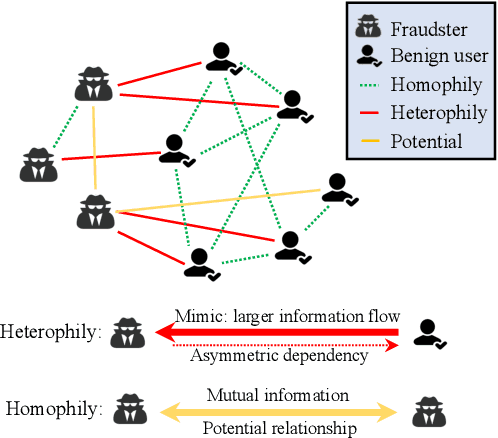

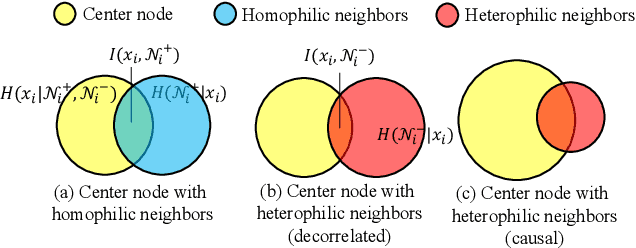
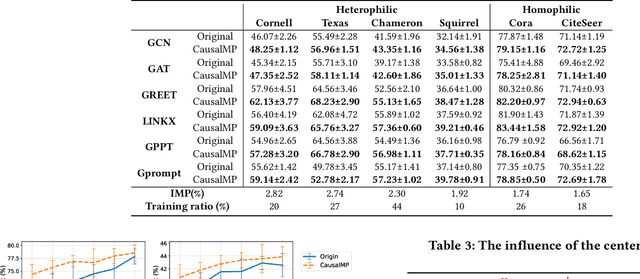
Abstract:In this work, we discover that causal inference provides a promising approach to capture heterophilic message-passing in Graph Neural Network (GNN). By leveraging cause-effect analysis, we can discern heterophilic edges based on asymmetric node dependency. The learned causal structure offers more accurate relationships among nodes. To reduce the computational complexity, we introduce intervention-based causal inference in graph learning. We first simplify causal analysis on graphs by formulating it as a structural learning model and define the optimization problem within the Bayesian scheme. We then present an analysis of decomposing the optimization target into a consistency penalty and a structure modification based on cause-effect relations. We then estimate this target by conditional entropy and present insights into how conditional entropy quantifies the heterophily. Accordingly, we propose CausalMP, a causal message-passing discovery network for heterophilic graph learning, that iteratively learns the explicit causal structure of input graphs. We conduct extensive experiments in both heterophilic and homophilic graph settings. The result demonstrates that the our model achieves superior link prediction performance. Training on causal structure can also enhance node representation in classification task across different base models.
On the Limitations and Prospects of Machine Unlearning for Generative AI
Aug 01, 2024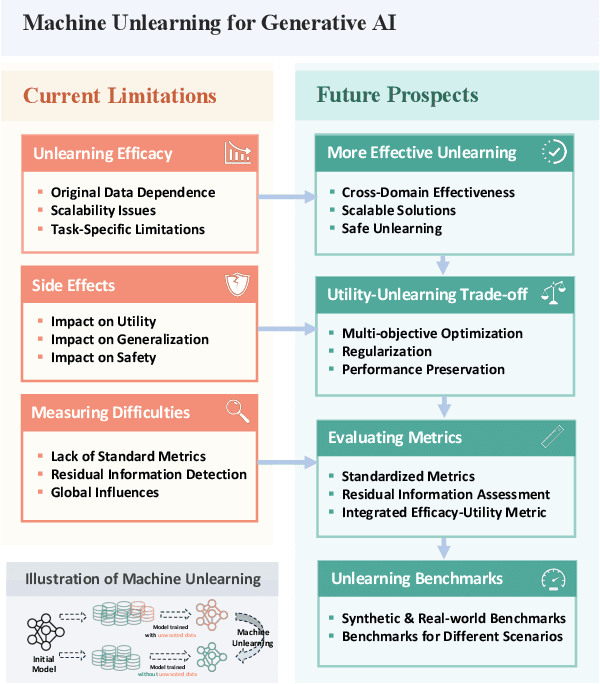
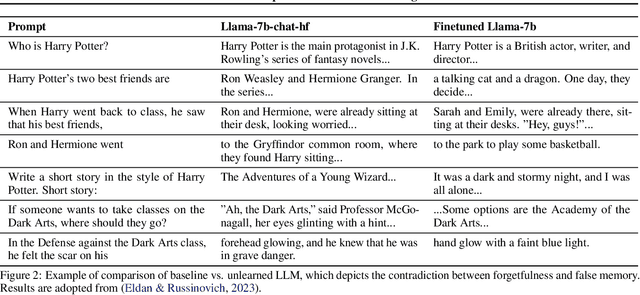
Abstract:Generative AI (GenAI), which aims to synthesize realistic and diverse data samples from latent variables or other data modalities, has achieved remarkable results in various domains, such as natural language, images, audio, and graphs. However, they also pose challenges and risks to data privacy, security, and ethics. Machine unlearning is the process of removing or weakening the influence of specific data samples or features from a trained model, without affecting its performance on other data or tasks. While machine unlearning has shown significant efficacy in traditional machine learning tasks, it is still unclear if it could help GenAI become safer and aligned with human desire. To this end, this position paper provides an in-depth discussion of the machine unlearning approaches for GenAI. Firstly, we formulate the problem of machine unlearning tasks on GenAI and introduce the background. Subsequently, we systematically examine the limitations of machine unlearning on GenAI models by focusing on the two representative branches: LLMs and image generative (diffusion) models. Finally, we provide our prospects mainly from three aspects: benchmark, evaluation metrics, and utility-unlearning trade-off, and conscientiously advocate for the future development of this field.
Hyperbolic Knowledge Transfer in Cross-Domain Recommendation System
Jun 25, 2024Abstract:Cross-Domain Recommendation (CDR) seeks to utilize knowledge from different domains to alleviate the problem of data sparsity in the target recommendation domain, and it has been gaining more attention in recent years. Although there have been notable advancements in this area, most current methods represent users and items in Euclidean space, which is not ideal for handling long-tail distributed data in recommendation systems. Additionally, adding data from other domains can worsen the long-tail characteristics of the entire dataset, making it harder to train CDR models effectively. Recent studies have shown that hyperbolic methods are particularly suitable for modeling long-tail distributions, which has led us to explore hyperbolic representations for users and items in CDR scenarios. However, due to the distinct characteristics of the different domains, applying hyperbolic representation learning to CDR tasks is quite challenging. In this paper, we introduce a new framework called Hyperbolic Contrastive Learning (HCTS), designed to capture the unique features of each domain while enabling efficient knowledge transfer between domains. We achieve this by embedding users and items from each domain separately and mapping them onto distinct hyperbolic manifolds with adjustable curvatures for prediction. To improve the representations of users and items in the target domain, we develop a hyperbolic contrastive learning module for knowledge transfer. Extensive experiments on real-world datasets demonstrate that hyperbolic manifolds are a promising alternative to Euclidean space for CDR tasks.
 Add to Chrome
Add to Chrome Add to Firefox
Add to Firefox Add to Edge
Add to Edge